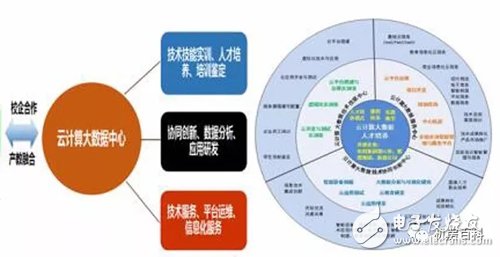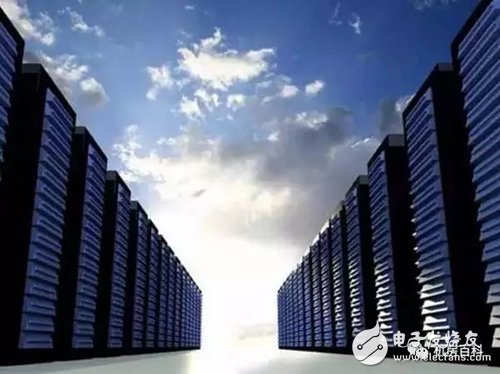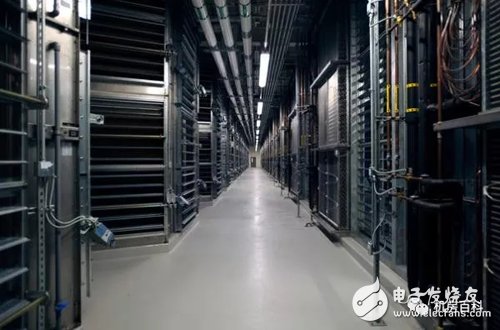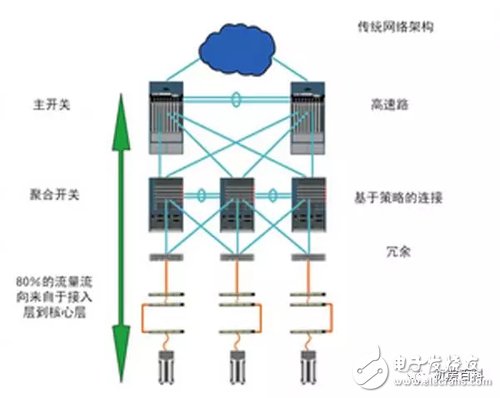A data center is a complex set of facilities that includes not only computer systems and other supporting equipment (such as communication and storage systems), but also redundant data communication connections, environmental control equipment, monitoring equipment, and various security devices. "At the moment, cloud computing is about to become a public resource of the information society, and the data center is the infrastructure that supports cloud computing services. Cloud computing does have the ability to bring about earth-shaking changes in the information age, so since cloud computing was born, Every information technology is starting to turn around. Cloud computing exists like a god. Let's look at what is the difference between a cloud computing data center, a cloud computing data center, and a traditional IDC.

What is a cloud computing data center?
There may be many people who are confused about technologies and rankings such as cloud computing, data centers, and big data. Cloud computing data centers are based on cloud computing architectures. The computing, storage, and network resources are loosely coupled. A new type of data center that virtualizes various IT equipment, has a high degree of modularity, is highly automated, and has a high level of green energy conservation.
The characteristics of the cloud data center are first of all high virtualization, including virtualization of servers, storage, networks, applications, etc., enabling users to call various resources on demand; followed by automated management, including physical servers and virtual servers. Management, automatic management of related business automation process management, charging for customer service, etc. Finally, green energy conservation, cloud computing data center meets green energy-saving standards in all aspects, and the general PUE value does not exceed 1.5.

In terms of design concepts, cloud computing data centers (or next-generation data centers) emphasize the synergy with IT systems to achieve the highest efficiency and lowest cost of the entire data center while meeting the demand; traditional data centers usually emphasize one-sided The computer room is reliable, safe, and high-standard, but it is costly apart from the IT system.
The traditional IDC can be roughly divided into two types: the hosted service and the user's own service. The first type is that the server is purchased by the user himself, and the monitoring and management of the device is also completed by the customer. The data center mainly provides services such as IP access, bandwidth access and power supply. Another mode is that the data center not only provides management services, but also provides servers and storage to customers. Customers can use the storage space and computing environment provided by the data center without purchasing equipment themselves, but now they are entering the IT industry in the era of cloud computing. In the data center hosting, users no longer need to provide their own hardware devices, but greatly improve the computing power and IT scalability and operability of hardware devices.

(1) The difference between cloud computing and traditional IDC in terms of resource intensification speed and scale
In the final analysis, cloud computing is a dynamic resource allocation through resource intensification. Traditional IDC services can also achieve simple intensification, but the two are very different in terms of resource integration speed and scale. Traditional IDCs only have limited integration on the basis of hardware servers, such as multiple virtual machines sharing a single physical server performance. However, this simple intensification is limited by the resource size of a single physical server, far less than the physical integration of cloud computing, or even large-scale effective integration across data centers.
More importantly, the resources provided by traditional IDCs are difficult to withstand rapid redistribution in a short period of time.
(2) The difference between cloud computing and traditional IDC in platform operation efficiency
More flexible resource application methods and higher technology enhancements enable cloud service providers to have a collection of advantages and innovative resource utilization methods to promote the efficiency of the entire platform. Moreover, unlike traditional IDC services, cloud computing frees users from the management and operation of hardware devices, focusing on the development and innovation of internal services. Cloud service providers are responsible for the stability of the cloud platform itself. This responsibility sharing model improves the operational efficiency of the entire platform.
Simply put, cloud computing is an extension and development of traditional IDC services. Cloud computing is to connect multiple computing nodes into a large virtual resource pool to improve computing efficiency, so that the efficiency and scale of resource redistribution are not limited to a single physical server or even a single IDC data center. Regardless of the delivery/service approach, the size of resource allocation, the speed of resource allocation, or the operational efficiency of the entire platform, cloud computing has greatly improved compared to traditional IDC services. This upgrade will be created for enterprises and developers in various industries. Higher value.

(3) The difference between cloud computing and traditional IDC in service types
Commonly used traditional IDC services include entity server hosting and lease. The former is purchased by the user and sent to the computer room for hosting. During the monitoring and management of the equipment, the equipment is independently completed by the user. The IDC data center provides IP access, bandwidth access, power supply and network maintenance. The latter is IDC. The data center rents physical devices for use by customers, and is responsible for the stability of the environment. Users do not need to purchase hardware devices.
The service provided by cloud computing is a continuous whole set of services from infrastructure to business infrastructure platform to application layer.
The IDC data center consolidates the scaled hardware servers into the cloud, providing users with service capabilities and IT performance. Users do not have to worry about the performance limitations of any hardware device, and can get high scalability and high availability computing power.
(4) The difference between cloud computing and traditional IDC in resource allocation time lag
It is well known that due to the deployment and configuration of physical hardware, the delivery of traditional IDC resources usually takes hours or even days, which will increase the time cost of the enterprise, and more energy consumption, and it is difficult to real-time and rapid resource redistribution. And easily cause resources to be idle and wasted.
In cloud computing, resources can be quickly redistributed through updated technologies, resources can be allocated quickly in minutes or even tens of seconds, and the huge resource size in the cloud virtual resource pool enables rapid redistribution of massive resources. And to effectively avoid the risk of resource idle.

(5) The difference between cloud computing and traditional IDC charging mode
Traditional data centers are generally charged on a monthly or annual basis. The calculation criteria are the number of cabinets, the size of the bandwidth, and the amount of electricity used. These data are extensive, and the statistics are not accurate enough, which often results in a waste of many resources. For example, a customer rents ten cabinets, but in fact only uses five, and the other five can be slowly brought online later, but the cost of the ten cabinets must be paid in advance, so that customers spend a lot of money. The cloud data center is different, even charging by hour or minute, and the customer is using computing, bandwidth and storage data, just like the gas fee used at home, as long as the gas stove is not turned on, it will not cost gas, gas meter Only when you turn on the gas stove, you can start to go. Accurately measure, the cloud data center is charged according to this mode. How much calculation and bandwidth resources the customer uses, how much will be charged, this cost can be accurate to the minute, saving customers Expenditure, so which customers can not like it.
(6) Cloud computing and traditional IDC have different requirements for optical devices
Compared to conventional devices, the density of devices used in the data center is higher, and more modules can be plugged in on the same board. Power demand plummeted to a level of one-eighth. The demand for speed is also getting higher and higher, because in a limited space, on a limited board, in order to achieve a larger amount of data, the speed of the module is required to rise linearly, all of these requirements are added together, and the required integration of the device The degree is getting higher and higher.

In the past, the traditional servers used to install a virtual host software to sell space, there is no market, and the slightly larger traditional IDC has also been upgraded to vps, but from the current point of view, the popularity is very general. And the price is expensive, and the customer development cost is high. On the other hand, due to the trouble of filing, large and medium-sized stationmasters turned to idc enterprises in the United States or overseas. Several foreign idcs basically realized virtualization and basic cloud computing, and the price was extremely low.
The survival of traditional small IDCs will be even more difficult, so a large number of customers who originally belonged to IDC will be transferred to cloud computing companies at high speed, and this is almost unstoppable. In addition to server hosting, the larger idc merchants in China will also suffer the most severe impact on their virtual hosting business. In addition, several major manufacturers of cloud computing are well-known enterprises, and consumers trust them much more than idc vendors.
to sum up:Next, the new cloud computing data center will attract more companies as the landing time approaches. Looking to the future, in the Internet industry and the traditional IT industry, more and more enterprises have begun to devote themselves to the service and operation of data centers. This includes many leading companies in the industry, and some experts pointed out that in the next 5 Cloud-based data center management and service models will become more common in 10 years.
LED flag screen totem on light poles or Outdoor led screen kiosk, can save installation cost and time by pulling down and updating the printing advertising for light box. you can also unified management of intelligent management system. advertising can be really controlled,The Outdoor flat screen Is expected to become a large-scale media after as new carrier of advertising.
Small body, big world, It is not only small pixel pitch for led display, but a small era of led screen!
The flag LED display kiosk on each road poles, not only can realize the comprehensive utilization of road poles, making the road no longer monotonous, but also can play content according to different festivals and beauty the city. At the same time, it will also provide the public with weather changes, environmental pollution and road access. bring more convenience to the public.
Priva provides professional intelligent Led light pole screen solutions and professional commercial LED display technology With a wealth of LED project engineering experience, Priva Led will meet customer`s varity needs.
Integrated design, easy to use
Operate controller inside, Optional of installation on back column and side of pole, Easy to transport & install.
Intelligent management and Large scale cluster control and management. easy and convenient
Managing multiple displays via cable, 3G, 4G, WAN and LAN; Could manage by mobile phone with APP. 1-1 and 1-N management One click to release, timing, updating AD.
Outdoor Led Flag Screen Totem,Outdoor Led Flag Screen,Outdoor Flag Screen,Slim Outdoor Led Poster
Shenzhen Priva Tech Co., Ltd. , https://www.privaled.com